A 21st Century, Solo Cruising
Sailing Canoe
19th century sailing canoes,
in W. P. Stephens’s prints, caught me in the 1980s. The
boats’ ideas and their elegance have held me since. They’d
promised fine travel a century ago, and they’d given it.
They had a nearly infallible auxiliary, were handily portable
by train or muscle powered cart, and they were fast. But their
usage and evolution slumped after bicycles and better roads
were built, and fossil fuel came to small boats.
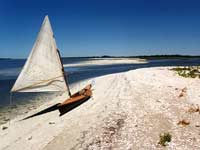 |
‘97 1) Puffin
on oyster shell Corrigan Reef, Cedar Key, Florida, with
her first rig, a battenless gunter.
click
images to enlarge |
| ‘99 2) Serendipity
with Meade Gougeon and her first rig on the Saginaw River,
Michigan. |
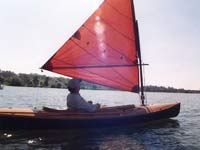
|
I studied photos and drawings, and reread their stories. At
Mystic Seaport and the Adirondack Museum, their graceful shapes,
and clear-eyed sincerity seduced me.
John Dowd’s, Sea
Kayaking: a Manual for Long Distance Touring,
1983, told me about folding Kleppers and their extraordinary
accomplishments. They were often fitted with a sailing rig,
placing them, to me, in the same genre of boats---sailing and
paddling about equally well---although Kleppers are built skin-on-folding-frame.
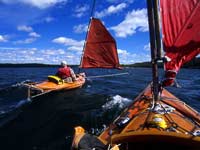 |
‘01 3) Serendipity
full reef back to Spragge, Ontario, Canada. |
| ‘02 4) Puffin
with batwing gunter, Serendipity, and Spirit with
Jan Gougeon, North Channel of Lake Huron, Ontario, full
reefs. |
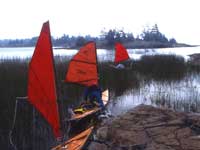
|
My mind’s eye saw gliding in the mist a sensual curve,
a bit of sheer---a modern decked, cruising sailing canoe.
In ‘86, beginning with a twenty foot Eddyline San Juan
three-holer, I invested in producing sailing kits for kayaks
and canoes. I fitted rigs to solo boats, and to smaller and
larger doubles and tandems, including Valerie Fons’s and
Verlen Kruger’s decked canoes. I tried many small boat
rigs, from the simplest to high aspect fully battened sails.
I kept testing and experimenting.
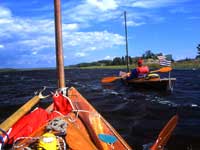 |
‘02 5) Serendipity
bare poles back to our takeout at Spanish, Ontario. Ron
Sell made our paddles. |
| ‘03 6) Serendipity sisters,
Saginaw River, first reefs. |
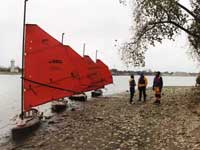
|
In ‘93 I sketched a multi-chine hull, borrowing some
of the shape from Russell Brown’s Brown Pelican kayak.
In ‘95 Ron Sell decked a Bell Canoe Works “Starfire”
hull for me, after we’d marked and cut a new sheer below
the paddlers’ pinched sheer. Dave Yost had drawn the 15’
x 34” Starfire for formal freestyle competition, paddled
as a tandem with single blades. The displacement and most of
the Starfire’s characteristics, particularly her deep
rocker and relatively full ends, work well for sailing cruising.
After I rigged her with a leeboard, rudder, spars, sail, and
seat, she became Puffin.
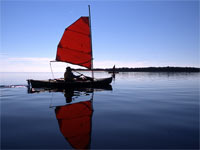 |
‘03 7) Walela
with Kayann paddling single blade at Cedar Key, first
reef. |
| ‘03 8) Walela
with Kayann at Cedar Key. |
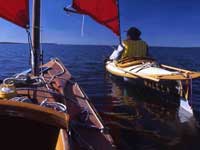
|
In ‘98 Meade Gougeon saw Puffin sailing and
wanted to buy her. Based on another carbon and Kevlar Starfire
hull, I built Serendipity for him and he built her
a new rig.
Then came six sisterships with the Gougeons’ help. But
instead of wood composite decks these were vacuum bagged, carbon
skinned and foam cored, except Howard Rice’s Sylph
which has a wooden deck like Serendipity’s. Jan
Gougeon added to his Spirit the best notion I’ve seen
for leeboard control, which I copied for my wife Kayann’s,
Walela.
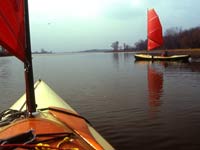 |
‘04 9) Meade’s
Serendipity Sister, Shiawassee National Wildlife
Refuge, Michigan, with the fattest fathead. |
| ‘05 10) Puffin
with Jan, and Serendipity, inside Atsena Otie Key,
Cedar Key. |
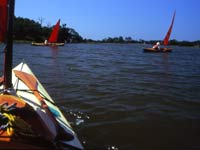
|
Meade’s style rig moves all the Serendipity sisters except
Howard’s. Puffin first had a battenless gunter,
the successor of which I built for Meade’s Serendipity.
Stu Hopkins suggested a true batwing gunter for Puffin.
Bill Ling’s gunter, shown on Bufflehead, is the
successor to Puffin’s batwinged gunter, and the
prototype for Bufflehead gunters.
Yost’s Starfire hull was my gauge and baseline for developing
the 15’ 5” x 33” Bufflehead design for plywood.
After twenty years of experiments and experience sailing canoes
and kayaks, with help and encouragement from many remarkable
people, Bufflehead is the result of the multichine shape I drew
in 1993.
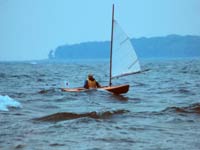 |
‘05 11) Sylph
reefed, Howard Rice, Lake Michigan. |
| ‘06 12) Sylph
and Howard with his main and jib on Brevort Lake, Michigan’s
Upper Peninsula. |
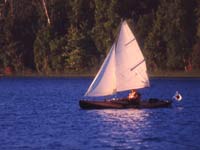
|
The goal is to improve the cruising sailing canoe, not duplicate
or reinvent it. Bufflehead’s intended use, however, is
the same as the 19th century sailing cruisers---pleasurable
travel after the adage, ‘Sail when you can; paddle when
you must!’
~Hugh Horton - hortonsailcanoe@wowway.com~

